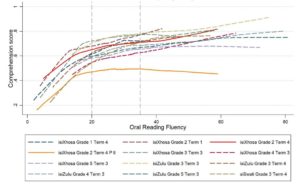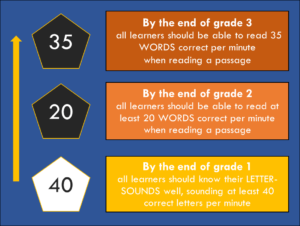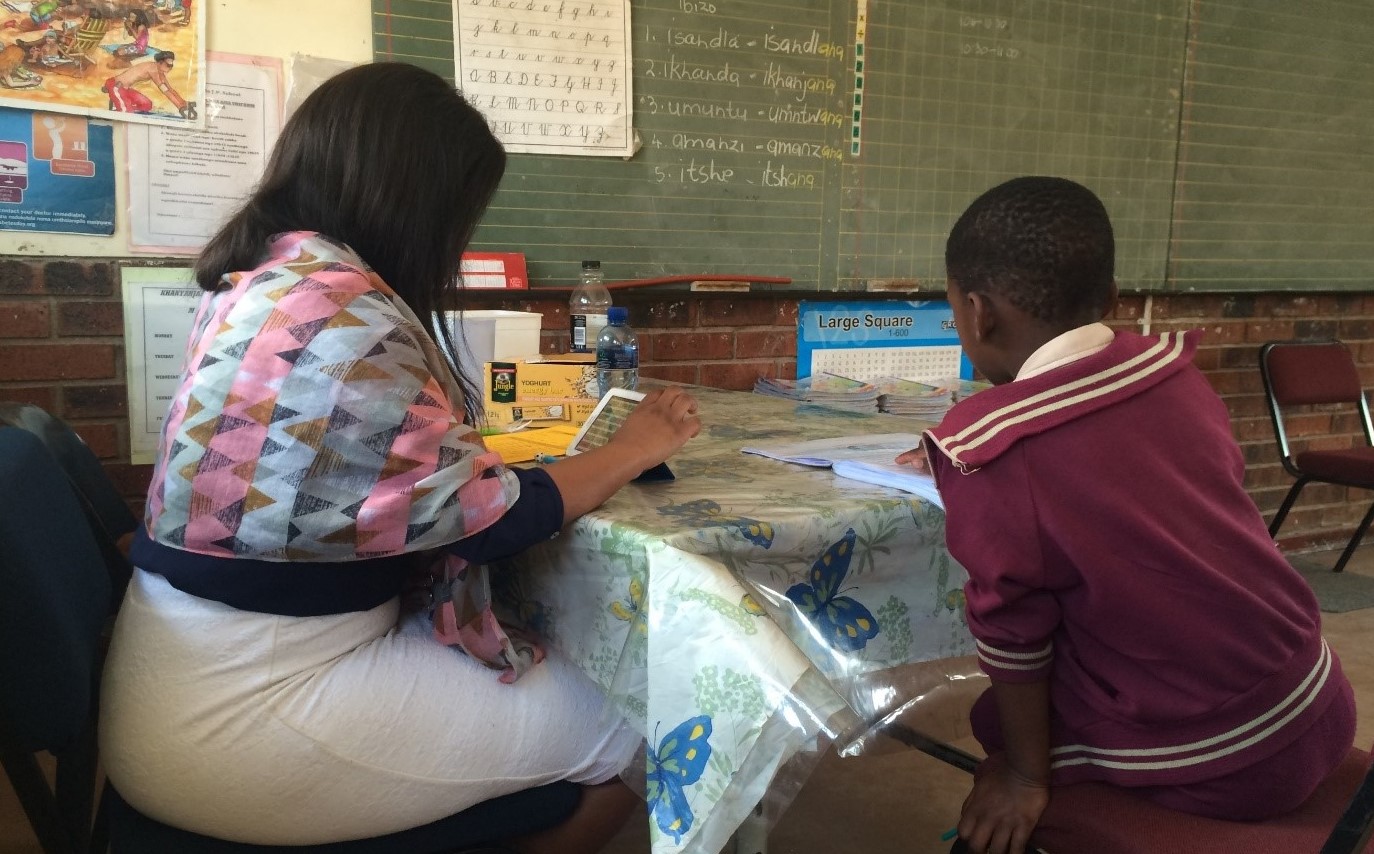By Cally Ardington (SALDRU)
This article was originally published online here: 20/11/2020
In early 2019 South African president Cyril Ramaphosa articulated a new and clear expectation for basic education: every child should be able to read for meaning by age 10. While reading for meaning is the goal of reading, reading is a complex and hierarchical process. A range of foundational reading subskills need to be mastered before one can comprehend or understand what is in a text. To prevent children from falling behind in the developmental sequence of reading, a shared vision of what reading success looks like at each step is required.
A multi-disciplinary team from SALDRU at UCT, RESEP at Stellenbosch University and NORC at the University of Chicago have collaborated to inform this shared vision through the establishment of benchmarks for foundational reading skills in three Nguni languages. The summary and technical benchmarking reports were recently launched by the Department of Education as part of their workshop on Reading Benchmarks for African Languages.
Reading benchmarks and thresholds are numerical measures of proficiency in specific reading skills, that may be used to monitor whether children are on track. They provide a standard against which teachers can measure learners’ reading subskills and identify early on learners who are at risk of not learning to read for meaning by age 10. This, in turn, supports remediation at an earlier age. Additionally, as specific learners reach different benchmarks, this can help teachers adapt their instructional focus to meet the learners’ needs at their reading level.
While reading benchmarks exist in English, there is scant research guiding the development of Nguni language reading benchmarks or thresholds. One cannot simply transfer reading benchmarks from English to the Nguni languages due to differences with the phonological, morphological and orthographical features of African languages (see Table 1). Benchmarking processes need to take account of the linguistic features of the language for which the benchmarks are being developed. At the simplest level, it makes no sense to compare fluency across languages with vastly different word lengths. Beyond that, one needs to allow for language specific accuracy-speed and fluency-comprehension relationships that characterise reading development.
Table 1: Some differences between Nguni languages, Sotho languages and English
| NGUNI LANGUAGES | SOTHO LANGUAGES | ENGLISH |
| Agglutinating Affixes and word stems are “glued” together to form new meanings. E.g. isiZulu: Bakufundisile Stem: fund |
Agglutinating Affixes and word stems are “glued” together to form new meanings. E.g. Southern Sotho: ba le rutile Stem: rut |
Analytic Use of helper words, prepositions, and word order to convey meaning. E.g. They taught you. |
| Transparent/ Shallow There is a one-to-one letter to sound correspondence. E.g. ‘g’ is pronounced the same in “ngoko” and “jonga” in isiXhosa |
Transparent/ Shallow There is a one-to-one letter to sound correspondence. E.g. ‘g’ is pronounced the same in “gape” and “morago” in Sepedi |
Opaque / Deep The same letter can represent different sounds in different words. E.g. the sound ‘g’ differs in the words: ‘gate’ and ‘germ’ |
| Conjunctive Morphemes (the smallest meaningful unit) are merged together into single written words. E.g. isiZulu: Ngiyabathanda |
Disjunctive Morphemes mostly appear as single words. E.g. Northern Sotho: ke a ba rata |
Disjunctive Morphemes mostly appear as single words. E.g. I like them |
The research team drew on learner assessment data from five different studies to compile the largest available source of information on early grade reading in three Nguni languages: isiZulu, isiXhosa and siSwati. When combined, these data contain multiple assessment points which can be compared over time for nearly 16,400 unique learners across 660 schools. While the data sample is not nationally representative, it provides a very clear indication of the foundational reading skills of learners in predominately no-fee schools, located across four provinces (Eastern Cape, KwaZulu-Natal, Gauteng and Mpumalanga) and in relatively high poverty contexts.
The researchers’ approach to benchmarking is based on a conceptualisation of different stages of reading development where different cognitive processes come into play as reading proficiency increases (see Figure 1). The importance of some earlier processes diminish as proficiency increases and they are replaced by qualitatively different processes. Yet across all the components, accuracy develops first, followed by increased processing speed, which then leads to automaticity (processing without effort or conscious attention). Fluency frees-up cognitive resources (e.g. working memory and attention) to be allocated to constructing meaning from text.
The research team drew on learner assessment data from five different studies to compile the largest available source of information on early grade reading in three Nguni languages: isiZulu, isiXhosa and siSwati. When combined, these data contain multiple assessment points which can be compared over time for nearly 16,400 unique learners across 660 schools. While the data sample is not nationally representative, it provides a very clear indication of the foundational reading skills of learners in predominately no-fee schools, located across four provinces (Eastern Cape, KwaZulu-Natal, Gauteng and Mpumalanga) and in relatively high poverty contexts.
The researchers’ approach to benchmarking is based on a conceptualisation of different stages of reading development where different cognitive processes come into play as reading proficiency increases (see Figure 1). The importance of some earlier processes diminish as proficiency increases and they are replaced by qualitatively different processes. Yet across all the components, accuracy develops first, followed by increased processing speed, which then leads to automaticity (processing without effort or conscious attention). Fluency frees-up cognitive resources (e.g. working memory and attention) to be allocated to constructing meaning from text.
Figure 1: Developmental cline in early reading

The study therefore first examines the relationship between accuracy and speed and then the relationship between fluency and comprehension. To avoid imposing a priori assumptions about the nature of these understudied relationships in Nguni languages, the study adopts non-parametric techniques to explore these relationships and to identify critical thresholds in early reading skills (see Figure 2). The study identifies thresholds and benchmarks for both oral reading fluency (correct number of words per minute of connected text) and the foundational skill of letter sound knowledge. Longitudinal data is then used to assess the predictive validity of thresholds or benchmarks for future reading success. Meeting the proposed thresholds or benchmarks is shown to be predictive of learners’ future reading proficiency scores. The study also establishes concurrent validity by examining the alignment of the proposed thresholds and benchmarks against the performance of the same learners on written comprehension assessments.
Figure 2: Relationship between oral reading fluency and comprehension for students attempting all questions

The study identifies the following thresholds and benchmarks:
By the end of grade 1 all learners should be able to read 40 letter-sounds correctly per minute.
- This appears to be a good early predictor of oral reading fluency later in Foundation Phase.
- Improvements in letter-sound knowledge tend to stagnate beyond this point.
- Once learners have achieved this level of letter-sound knowledge, decoding instruction should focus on helping learners apply word attack strategies and develop fluency.
By the end of grade 2, all learners should be able to read at least 20 correct words per minute.
- This is a minimum threshold. If learners do not reach this level of fluency, higher order reading skills are very unlikely to develop. Below this threshold there is little evidence that learners can comprehend what they have read, evidenced by very low oral comprehension or written comprehension scores.
- By the end of grade 3, between 53% and 76% of the learners in the sample had reached this grade 2 threshold.
By the end of grade 3, all learners should be able to read 35 words correctly per minute.
- At this level of fluency reading comprehension becomes increasingly possible when learners read on their own.
- Once learners reach this level of fluency, it appears that poor comprehension skills become the limiting factor to further literacy development.
- Therefore, at this milestone, teachers should focus on teaching learners the skills and strategies needed to tackle comprehension while encouraging vocabulary and language development.
- Fluency skills should continue to improve from this milestone.
- Approximately only a quarter of learners in the Early Grade Reading Assessment (EGRA) studies analysed had reached the upper fluency benchmark by the end of grade 3.
Figure 3: Reading benchmarks and thresholds for early grade reading in Nguni languages

In addition to being empirically and theoretically grounded, the suggested thresholds and benchmarks are valid for the South African context. They are not set so high as to be out of reach for most early grade students in poor South African school contexts. Yet, they establish expectations that are sufficient to move teachers, students and schools on a journey of reading excellence. Supporting wider national reading efforts, this study provides simple metrics that can be used by policymakers, teachers and parents to clarify reading success in the early grades. The benchmarks provide a standard against which teachers can measure students’ reading subskills and identify early on students who are at risk of not learning to read. This, in turn, supports remediation at an earlier age. At the national level, the suggested thresholds and benchmarks provide clear and measurable standards to track whether cohorts are developing foundational reading skills. This is necessary where the South African school curriculum is currently silent on how to measure a student’s achievement in specific reading subskills in African languages.
Image credit: Gabrielle Wills







